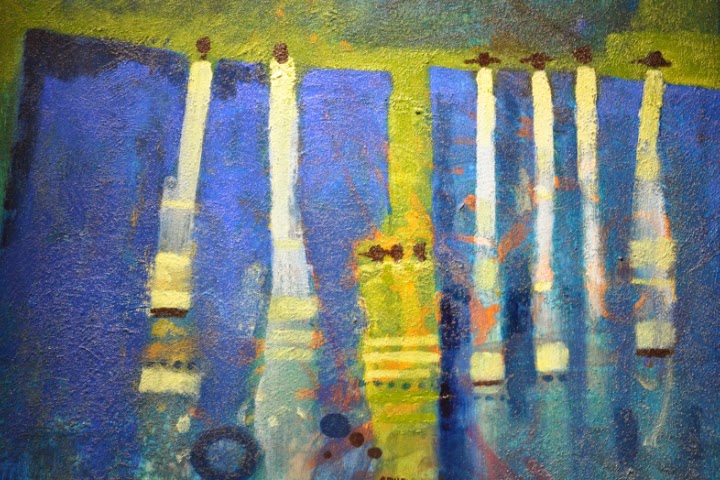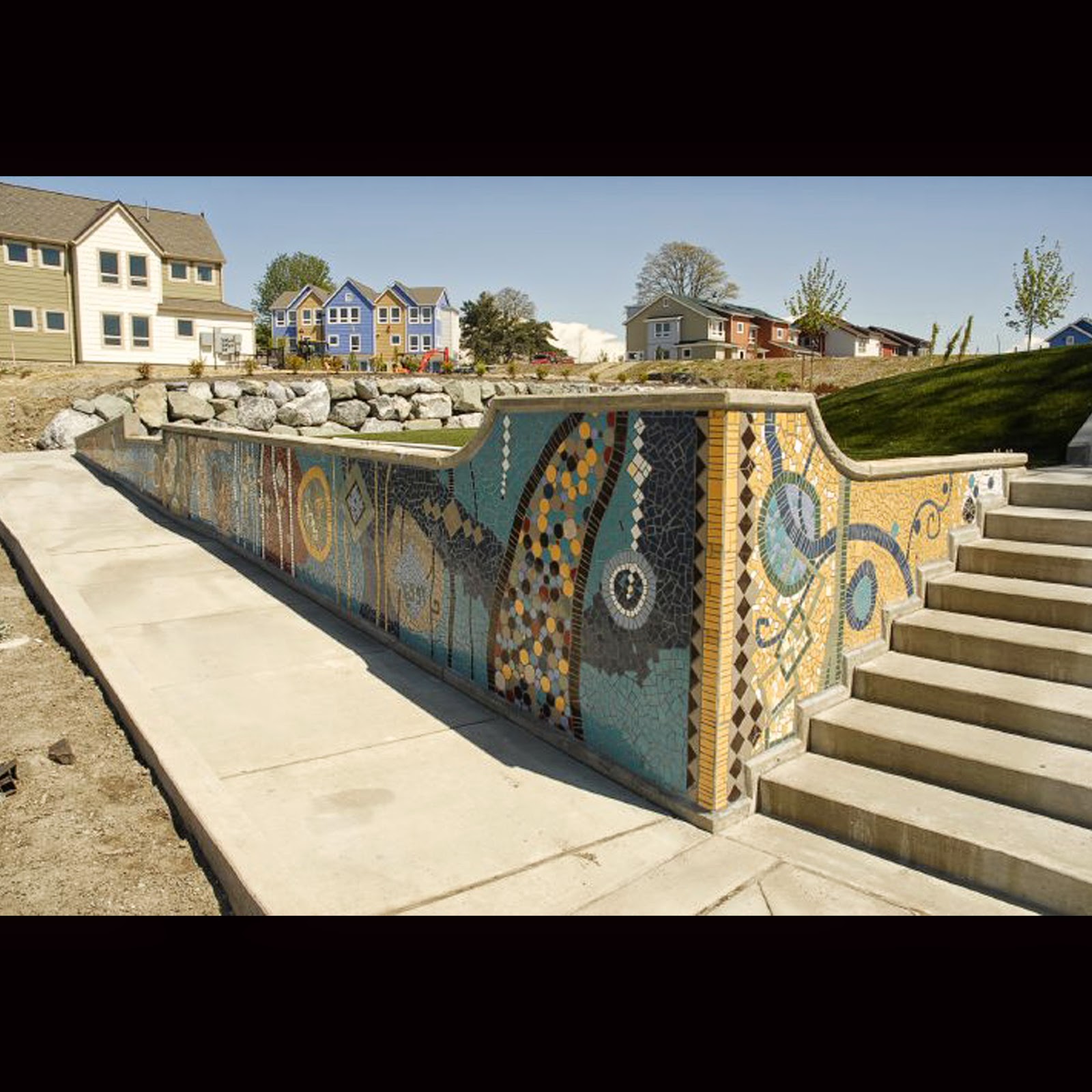Great Work of Art Comes from Within
As January 14th, 2011 had an exceptionally bright morning for the coldest season of Asmara, it was a pleasant element to discuss about art outdoors over a macchiato. The artist was so punctual that he had already been waiting – his almost empty cup of macchiato shows it – in the green area of Emba-Soira Hotel in the warmth of the late morning sun of that day.  Excusing my tardiness, artist Yegizaw Michael, also known as Yeggy, led our discussion taking off from his comments about the spacious garden café of the hotel, and landing on his art works and the processes they pass through from their inception in his mind to their delivery to audience.
Excusing my tardiness, artist Yegizaw Michael, also known as Yeggy, led our discussion taking off from his comments about the spacious garden café of the hotel, and landing on his art works and the processes they pass through from their inception in his mind to their delivery to audience.
 Excusing my tardiness, artist Yegizaw Michael, also known as Yeggy, led our discussion taking off from his comments about the spacious garden café of the hotel, and landing on his art works and the processes they pass through from their inception in his mind to their delivery to audience.
Excusing my tardiness, artist Yegizaw Michael, also known as Yeggy, led our discussion taking off from his comments about the spacious garden café of the hotel, and landing on his art works and the processes they pass through from their inception in his mind to their delivery to audience.
Yeggy is an Eritrean national who had lived and worked in Kenya in the early 1990s, and who won the “Best Artist of the Year” award there in 1995. He also brought home twice the Raimok award for painting in the national festival of 1996 and 1997 for his works “Life Metaphor” and “Nigdet” respectively. Yeggy came up with the idea of creating awareness about HIV/AIDS through art in Eritrea in 1996. His concept, with the assistance of National Union of Eritrean Youth and Students and UNFPA, materialized into “Artists Against AIDS” in which over 30 artists – painters, musicians, playwrights, actors – took part.
Remembering this, artist Michael Adonai, one of the leading artists in Eritrea, says that he was able to know Yeggy as a person and artist in the second half of 1990s. Artist Michael, who was a member of the jury for painting in one of the festival occasions when Yeggy won the Raimok award, says that there was almost none that could contend Yeggy’s work then. It was able to get the award with a unanimous vote of the members of the jury. His coming to Eritrea then made the Eritrean art activity very colourful with his distinct works as he was not an artist who just blends in with what was here, he explains.
 |
| Crossing the Sea |
Artist Yegizaw compares art with language as used in poetry. A poet uses words and then elevates the work through various elements of figurative language; similarly a painter’s basic words are lines, colours, compositions… which then could bring out a certain work in different style. The style could be so specific to a certain artist to an extent of revealing his identity, soul or inner feelings. Although he admitted that some extraordinary artists may just come out with their own styles without prior knowledge of the basics of art, artist Yegizaw is of the idea that knowing the basics gives the artist much freedom and flexibility in the delivery of the work of art.
Coinciding with this, artist Michael states that Yeggy, who is friendly and modest as a person, has works which stand out for their simplicity, colour selection and depth of their topics resulting in his distinct style.
Yegizaw says the process of his painting is a struggle between identifying himself with his mind or his inner feelings. For him, the mind, in creative context, evades the present but just dwells in the past and future. Although the past is an important reference in his works, he has to feel the present to produce an enduring work, he stresses.
In this struggle of opting for what he thinks or feels, Yegizaw illustrates that choosing the mind is censoring oneself as an artist. The artist would be swept off his feet by what is popular with audience and would become judgmental about what he does. The result would then be for temporary consumption as it is going to end up as a design leaning towards propaganda.
 |
| Endless Prayer |
Going through such a process as an artist for over 20 years – after attending the School of Fine Arts in Addis Ababa (where he grew up) from 1988 to 1990 – Yeggy remembers the times when his mind had upper hand in his creative endeavours. His idea, “I will die as a person but not my work,” disengaged him from working with his mind siding with working from his spirit and/or inner feelings. A pure work of art that imparts lasting feelings, opposed to dry illustrations, comes from listening to your feelings, passionately says Yeggy.
Naturally, our mind controls every move we do, the decisions we take and the reactions we bring against any action. It might also be difficult to imagine how one can control the one that is always thought to be in control of our being. Yeggy, however, draws a fine line between controlling and being controlled by our mind. All the information that the mind has stored over one’s life time is still a useful material for the work of art; it is not though organized into the work on canvas by the mind. Yeggy states, keeping the mind in quietness and stillness while it is still providing, subconsciously, the experiences and information stack away in it enables him to immerse himself in his spirit and/or inner feelings and work without any fears, criticisms and judgments that create limitations.
Elevating this further, Yeggy clarifies that the product will still be related with the society he lives in for the experiences and information he uses are still taken from the society by his mind, sieved into his spirit – refined and organized – and delivered on his canvas as a reflection. Since such process of creating works of art tend to be done impulsively, the artist may instinctively produce a certain pattern of themes or style marking a certain period.
Similarly, artist Michael agreeing with this adds that an artist shouldn’t work calculating what his audience would think about his piece. Be it in painting or writing, there should be a connection between the artist and the work that will have lasting attachment.
 |
| Melody Flyer |
Relevant to this, artist Yosief Abraha, who recently exhibited his collage works, says that one should stop when all his feelings are brought out on the canvas – a comment he got from Yegizaw and found effective. Thanking him, Yosief states that Yeggy visiting him at his studio appreciated some works which he had left as unfinished. He says that he used to minimize or add some details on his works for an extended period of time. This difficult part of painting – when to say done to a certain work – Yosief indicates was revealed to him by Yeggy.
Yegizaw’s 2009 painting exhibition in New York City under the title “Crossings: A Visual Exploration of Crisis” was a collection of works produced in a similar process. The news item about the death of an Eritrean mother with her daughter while crossing the border between Israel and Egypt a year or months before 2009 was so shocking for Yeggy; however, he didn’t know that it could be a source of inspiration for his future works then. Although he was able to analyse and explain this and similar other stories intellectually or in any other means, he didn’t think of painting intentionally about them. Nonetheless, the process, which is led by what he feels or by what lingers in his spirit, brought similar stories to his canvases unexpectedly. Yeggy stressed that there was no premeditated intention or purpose in it but a simple reflection of human suffering that touched him deeply; he himself found out the pattern after collecting his pieces to get ready for the exhibition. For him the works exhibited in “Crossings” epitomize the psychological, social, physical and geographical crossings humans incessantly experience in their lives, be it in peace or war time.
This theme that has universal appeal is explained more by artist Michael Adonai as a recurring element. He asserts that Yeggy doesn’t seem to try to bring out themes restricted to local audience; on the contrary, he continues that Yegizaw with works that has some influence of the Coptic art touch on universal topics as in love, motherhood and other global issues. His forms that are so distinct and yet not taken directly from reality, his colour selection and contrast have simplicity that I like best about his work, artist Michael indicates.
 |
| Moment 2 |
Yeggy’s works being semi-abstract and realism with fewer details, Yeggy says that it is not a style which came up by worrying to stick with it. It is rather a development that an artist arrives at after having a control over the art. He remembers a stage when he was in search of that control which he described to have been sufficiently good but different from the stage he is at now – similar yet much sophisticated and with more layers in it.
To be able to have control over your creative work is meant for Yeggy to use it as a self-expression to an extent of making it a healing process with which one lets out his passion. Here the question of the work’s audience pops in; however, he says that if the artist is going to put into consideration what the audience would think the process will only be a job that may not be undertaken with passion and that ends up dry.
Yeggy goes on to say that creating a work of art which does not have profound effect on the artist would feel like lying to oneself. He said, “If I, living in Eritrea, paint snow which I have never experienced, the snow will not feel cold like snow.” Such a work should not be expected to have some effect on audience either.
Speaking of audience, Yeggy expects them to interpret his works in many different ways in relation to their experiences. That being the main point of his process of painting, the works would not be limited to pass on one theme or message. If he has to bear in mind in passing on a certain message or theme, for him the timelessness he seeks from his paintings will cease.
For works that are meant to pass on certain thought-out themes, Yeggy practises public art which he has already produced a number of them over more than ten years of his residence in the USA. Yeggy explains that this type of work follows opposite process in its making. As its name indicates, public art is produced for public consumption for they are usually placed in public areas where people would enjoy and appreciate the work.
 |
| Totem of Community |
Although the public art he produces still need to be big in size, permanent, with aesthetic value, attractive, a reflection of the people’s way of thinking, with which they identify and to be mounted where many people come together, Yeggy still need to present them with his artistic and creative input. This type of work to be displayed in the form of mosaic, metal installation, mural, sculpture, relief … require him to do extensive research on the society to whom it will be exhibited. Therefore, the work is handled objectively with some judgements as opposed to his paintings that are personal. Simply stated, in public art the process follows the artist studying the society (audience) then presenting it on the canvas, while in painting the artist puts up his work on the canvas then takes it to the audience. The artist uses his painting to lead the society; in public art, on the contrary, the artist follows the society. Yeggy indicated that some works of public art by some artists have been taken down as the people found them to be offensive and contravene their morality.
Works of public art could have elements that create national identity among the people of a country or the city where they are mounted. Yeggy also says that they could also be appreciated by everyone especially by those who could not afford but love art. In such works that he produced Yeggy was able to leave some elements of his identity that made him what he has become. In his work titled “The Moment” – mounted in Seattle, USA – he has included some Geez alphabets and words in Tigrigna language.
Yeggy, who is often invited to lecture on his process of painting in several universities in the USA, enjoys teaching art to children. He is also interested to make works of public art in Eritrea if he found some cooperation from city administrations and/or government institutions.
Since Yeggy is a member of Segen Artists Group, he was able to meet up with some artists and visit their studies. He thinks that many young artists are budding and what he has seen shows that there is a vibrant art activity in Asmara despite some shortages of materials. He also comments that there should be an art centre that creates conducive environment for art criticisms and discussions.

